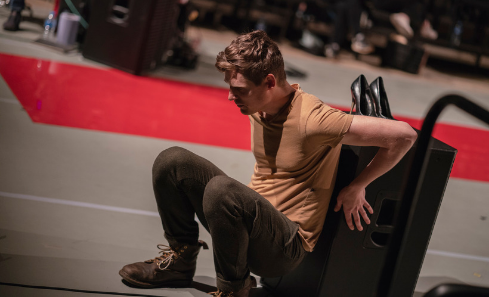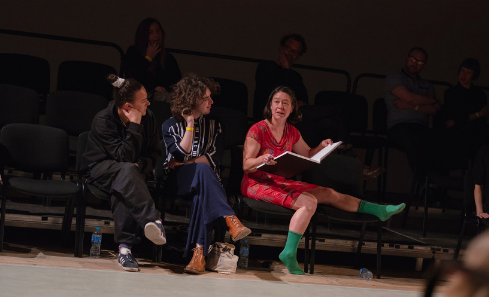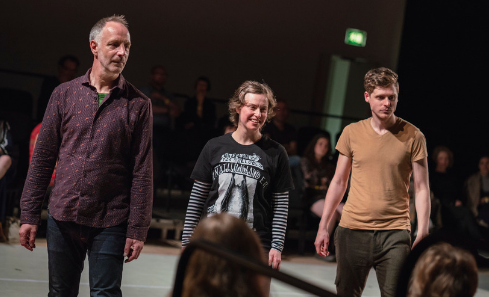On Friday 22 March, award-winning theatre and performance company Quarantine will bring their first ever 12-hour performance of the critically-acclaimed show, Wallflower, to Universal Hall in Findhorn, in association with Dance North Scotland.
Wallflower has been described as a "marathon of dance and memory", as from midday to midnight, seven performers will try to remember every dance they’ve ever danced.
And while some of them are professional dancers - indeed, some are not.
Ahead of the performance, Quarantine have been in Findhorn asking local people to share their own remembered dances.
These were recorded in images and text and will be displayed – alongside remembered dances collected across the UK – on a dedicated website.
They will also be shown at Universal Hall during the performance, painting a portrait of the local community.

(Image: GIFT/Richard Kenworth)
Speaking about the performance, Dance North's Creative Director Karl Jay-Lewin said, "what interests me is the way in which Wallflower manages to touch and inhabit a variety of different worlds - dance, theatre, music, art, the importance of one-to-one relationships, and the importance of building communities.
"This is an epic piece by an award-winning theatre company who rarely present work in Scotland, and we're delighted to host them in Findhorn."
I think there’s a huge generosity in the performer who invites us simply to look, to gaze at another human. Dancing is an active, hugely complex and varied performance form to do this through- Richard Gregory, Quarantine
Quarantine's Director Richard Gregory explained that Wallflower was originally conceived in 2015, when they set out to make a "light-on-its-feet" touring piece.
He'd been working with two performers - Sonia Hughes and Jo Fong - who’d been in an earlier piece called Entitled.
While they were exploring ideas, he returned to an exercise that he'd undertaken with Jo and Sonia during the Entitled auditions: sitting opposite each other, describing every dance they'd ever danced.
"So this time, I asked them to stand up and to dance some of the dances," he explained.
"Immediately, we knew we’d found an interesting and engaging way of creating performance self-portraits - try as we might, we couldn’t move away from this simple task."

(Image: GIFT/Richard Kenworth)
After a period of research, development and rehearsal, Wallflower was born.
"We chose the title because we recognised that the work needed someone to watch and not dance, as much as it needs the dancers," Gregory said.
"We rehearsed and did a work-in-progress performance at HOME in Manchester, then the premiere took place at Noorderzon Festival in the Netherlands.
"Since then we’ve toured to Sweden, Canada, Ireland, Wales and lots of gigs in England. This will be our first outing in Scotland."
Although the work features both professional dancers and non-professional dancers, Gregory says there isn't a huge difference in the way the performances are approached.
"Every time we perform, most of the performers will say something like 'I don’t know how I'm going to manage tonight - I really can’t remember any more dances...'," he said.
"And then we start the process, with a rehearsal that flows into the performance, and they begin to spark off each other.
"One person’s remembered dance will provoke or stimulate the memory of another. It works like a conversation."
There are now ten people who have performed in Wallflower, and in Findhorn, seven will be on stage.

(Image: GIFT/Richard Kenworth)
"From the beginning, I very deliberately tried to curate a spectrum of experience of dancing - from Jo Fong, Karl Jay-Lewin and Charlie Morrissey who have spent much of the last 30 years dancing professionally all over the world, to artists like Nic Green and Simone Kenyon who use dance and choreographed movement in their performance practice, to someone like performer James Monaghan who, when I asked him if he’d like to be involved, told me he couldn’t dance," Gregory said.
"And of course he can. I wanted that range of relationships with movement - from the virtuosic to the fabulous social dancer to the awkward or uncertain - to create the complex texture of the work."
This is the first 12-hour version of Wallflower that the company is showing, but Gregory said it has been an ambition of his since they first performed a five-hour version.
"When we made the piece, I realised that the longer form brought something very rich into its performance," he said.
"The 90-minute version is tight and shaped and has its own dynamic quality.
"But as soon as the frame gets wider through time being stretched, other possibilities open up - the performers and, crucially, the audience somehow relax into it. It allows for everyday experience to have its place - the small things, the seemingly insubstantial or even the banal.
"And that somehow heightens the power of the moments that really are extraordinary. We’ve always been interested in de-heroicising performance - making a space where you know that it could be you up there - and letting everydayness in does just that.
"When Karl Jay-Lewin came in as a performer and talked to us about doing the show in Findhorn, he was interested in being the first host of a 12-hour Wallflower. We jumped at the chance.
"There’s something a bit magical for us - most of us travelling a long way to get to Findhorn and then doing this mammoth show. We don’t know quite what will happen - and that’s thrilling."
Gregory said that Wallflower works on "so many different levels", describing it as "a piece of live self-portraiture."
"I think there’s a huge generosity in the performer who invites us simply to look, to gaze at another human. Dancing is an active, hugely complex and varied performance form to do this through. And, of course, so familiar. We’ve all experienced dancing, one way or another.
"They’re portraits of these people dancing, in a particular room in front of a particular group of people at a particular moment in time. What they think they’re showing and what you think you’re looking at might, of course, be quite different things."
But although there are important ideas to take away, Gregory has said he doesn't ever set out to make work with a singular message.
"I have no idea what audiences bring in with them - who they are, what their own memories and experiences are, their mood that day, their experience of seeing performance," he said, "so I can’t presume to know how they might respond.
"It’s one of the things that I love about going to theatre myself and about making it - that I have no idea what other people are thinking or what effect the work is having.
"It’s not a crossword puzzle with a right answer. Wallflower offers us the opportunity to spend time - in this case, a relatively long time - in the presence of others, watching, listening, thinking about the work, thinking about other things.
"I don’t want to intrude on that experience or attempt to shape it. So I hope that people will take away something of their own, that I’ll never be aware of…."
Wallflower: Universal Hall, The Park, Findhorn; Friday 22 March; 12pm - 12am; £12 (£10).